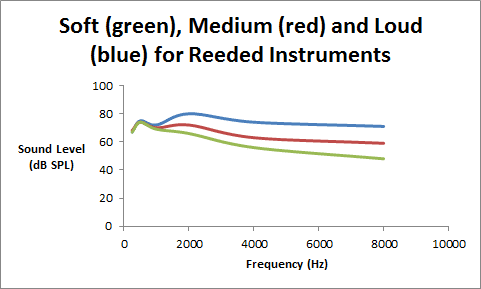This is the sec0nd post in a four-part series that touches on some of the problems associated with selecting the programming features for a “music program”. Last week’s post talked about the features of speech and how they may differ from those of music. Part 2 (this week) and Parts 3 and 4 (to be published after a one-week break for the holidays) will talk about the various characteristics of reeded musical instruments, stringed instruments, and brass instruments, respectively.
Last week’s post (“Soft, Medium, Loud for Speech and Music- Part 1… for speech) examined how the spectral shapes differ for soft, medium, and loud speech. Specifically, as speech gets louder, the lower-frequency vowel sound energy grows faster than the higher-frequency consonant energy. While this is complex, it is well understood and has been incorporated in the technology of modern hearing aids. In contrast, for music, it depends on the type of music being played- specifically whether the musical instrument has a reed such as a clarinet or saxophone, or whether it is a string or brass instrument.
The acoustics and mechanical characteristics of musical instruments have also been well studied, but by scientists who don’t normally go to audiology conferences or publish in audiology journals. And audiology researchers don’t normally go to music conferences. Only a few straddle the two fields of music and speech sciences.
Unlike the monolithic face of speech with a single, well-defined, long-term average speech spectrum, musical instruments have several spectral faces; one of these (reeded musical instruments) is shown below.
Reeded instruments:
When I play my clarinet and measure the spectral output at a soft level and again at a very loud level, I am constantly amazed that the level of the fundamental frequency (the low-frequency note name) doesn’t change more than a decibel or two, but the higher-frequency harmonics diverge significantly. As I play my clarinet louder, only the higher-frequency (harmonic) levels increase- not the lower-frequency fundamentals. This high-frequency increase is related to the non-linear distortion characteristics of the reed, and it is this part of the musical instrument that imparts its unique “woodwind” sound. Reeded instruments include the clarinet, saxophone, oboe, bassoon, and English horn.
As a clarinet or saxophone is played louder, a person with a hearing aid would require less amplification (as is true of speech as well), but only in the higher frequency region. The difference, then, between a soft, medium, and loud playing level is restricted to the higher frequencies- almost the opposite of speech as the three different speaking levels.
This may pose a fitting problem for the hearing healthcare professional if the music contains other non-reeded instruments. Do we optimize the response for reeded woodwinds (level-dependent, high-frequency changes) or do we also pay homage to the strings and brass instruments? In a quiet jazz band where the clarinet may be the lead, this high-frequency level dependency would be optimal, but how often does that happen? Perhaps, this “reeded strategy” would only be useful (and probably very useful) when reeded woodwind players are practicing and rehearsing solo?
This, like many topics that sit on the boundary edge between speech and music, would make a wonderful Capstone essay for any intrepid AuD student in their final year of study…..







